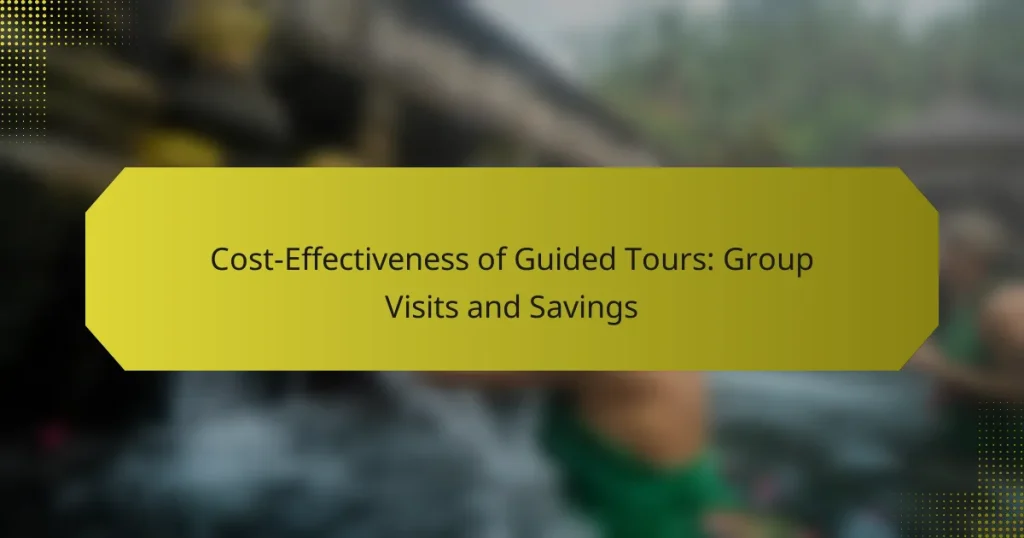Guided tours present a cost-effective solution for group visits by offering discounted rates and inclusive services that enhance the travel experience. By participating as a group, travelers can enjoy lower prices while benefiting from expert guidance and various amenities. Choosing the right tour requires careful consideration of factors like itineraries and group size, ensuring that the experience aligns with both interests and budget for maximum savings.

How do guided tours save money for group visits?
Guided tours save money for group visits primarily through discounted rates and included services. By booking as a group, participants can access lower prices and various amenities that enhance the overall experience while keeping costs manageable.
Discounted group rates
Many tour operators offer discounted rates for groups, which can significantly reduce the cost per person. Typically, groups of 10 or more may qualify for these discounts, resulting in savings that can range from 10% to 30% compared to individual ticket prices.
When planning a group visit, it’s essential to inquire about these rates early in the booking process. Some operators may require a minimum number of participants or advance reservations to secure the best pricing.
Included amenities
Guided tours often include various amenities that can save additional money for group visits. These may encompass meals, entrance fees, and even equipment rentals, which can add up if purchased separately.
For example, a guided city tour might include lunch at a local restaurant, saving each participant the cost of dining out individually. Always check what is included in the tour package to maximize value.
Shared transportation costs
Shared transportation is another way guided tours help groups save money. Instead of arranging individual travel, groups can utilize charter buses or vans, which are typically more economical than personal vehicles or taxis.
Additionally, shared transportation can enhance the experience by allowing participants to relax and enjoy the journey together. When booking, confirm the type of transportation provided and any associated costs to ensure transparency in pricing.

What are the benefits of group guided tours?
Group guided tours offer several advantages, including cost savings, enhanced experiences, and expert guidance. These benefits make them an attractive option for travelers looking to maximize their enjoyment while minimizing expenses.
Cost savings
One of the primary benefits of group guided tours is the potential for significant cost savings. By traveling in a group, participants can often take advantage of bulk pricing for accommodations, transportation, and attractions, which can reduce overall expenses.
For example, a guided tour may offer package deals that include meals and entry fees, often at a lower rate than booking each component separately. Travelers can save anywhere from 10% to 30% compared to individual bookings, depending on the destination and tour provider.
Enhanced experiences
Group guided tours often lead to enhanced experiences, as they provide opportunities for social interaction and shared memories. Travelers can bond with fellow participants, making the journey more enjoyable and enriching.
Additionally, group tours frequently include exclusive access to attractions or events that individual travelers might not be able to experience on their own. This could range from private museum tours to special cultural performances, adding depth to the travel experience.
Expert guidance
Having an expert guide is another significant advantage of group guided tours. Guides are typically knowledgeable about the local culture, history, and attractions, providing valuable insights that enhance understanding and appreciation of the destination.
Moreover, guides can navigate logistical challenges, such as transportation and language barriers, allowing travelers to focus on enjoying their trip. This support can be particularly beneficial in unfamiliar locations, where local customs and regulations may differ significantly from what travelers are accustomed to.

How to choose the right guided tour for groups?
Selecting the right guided tour for groups involves evaluating various factors such as tour operators, itineraries, and group size options. Prioritize your group’s interests and budget to ensure a fulfilling experience that maximizes savings.
Evaluate tour operators
Consider operators that specialize in group tours, as they often offer tailored packages that can lead to better pricing and enhanced services. Check if they are members of recognized travel associations, which can indicate adherence to industry standards.
Compare itineraries
When comparing itineraries, focus on the destinations, activities, and duration of the tour. Ensure that the itinerary aligns with your group’s interests, whether it’s cultural experiences, adventure activities, or relaxation.
Look for tours that include unique experiences or exclusive access to attractions, as these can add significant value. Additionally, check for any hidden costs in the itinerary, such as entrance fees or optional excursions, to avoid surprises.
Assess group size options
Group size can significantly impact the tour experience. Smaller groups often allow for more personalized attention and flexibility, while larger groups may offer cost savings through bulk pricing.
Determine the ideal group size for your needs by considering the type of experience you want. For instance, if intimate interactions and detailed guidance are priorities, aim for groups of 10-15. Conversely, if budget is a primary concern, larger groups of 20-30 may be more economical.

What are the popular destinations for group guided tours?
Group guided tours are popular in various destinations around the world, offering travelers a chance to explore significant sites while benefiting from shared costs. Common locations include national parks in the USA, cultural cities in Europe, and historical sites in Asia, each providing unique experiences and opportunities for savings.
National parks in the USA
National parks in the USA, such as Yellowstone and the Grand Canyon, are prime destinations for group guided tours. These parks offer breathtaking landscapes and diverse wildlife, making them ideal for nature enthusiasts. Group tours often include transportation, park entry fees, and guided hikes, which can significantly reduce individual costs.
When considering a group tour in a national park, look for packages that include meals and lodging, as these can enhance the experience and provide additional savings. Popular tour operators often offer discounts for larger groups, so it’s beneficial to travel with friends or family.
Cultural cities in Europe
Cultural cities in Europe, like Paris, Rome, and Barcelona, attract many group guided tours due to their rich history and vibrant art scenes. These tours typically cover major attractions, such as museums and historical landmarks, allowing participants to skip long lines and gain insights from knowledgeable guides.
Travelers should consider booking tours that offer flexible itineraries, which allow for personal exploration alongside guided experiences. Group discounts are common, and many tour companies provide special rates for students or seniors, making these cultural explorations more accessible.
Historical sites in Asia
Asia is home to numerous historical sites, such as the Great Wall of China and the temples of Angkor Wat, which are frequently included in group guided tours. These tours often focus on cultural education and provide context that enhances the visit, making them a valuable option for history enthusiasts.
When selecting a tour, consider the duration and depth of the itinerary. Some tours may offer multi-day packages that include local accommodations and meals, which can provide a more immersive experience. Always check for reviews and ratings to ensure the quality of the tour operator.

How do seasonal factors affect guided tour pricing?
Seasonal factors significantly influence guided tour pricing, with variations in demand leading to different price points throughout the year. Understanding these seasonal trends can help travelers save money by choosing the right time to book their tours.
Peak vs. off-peak pricing
Peak pricing occurs during high-demand seasons, such as summer and major holidays, when tour prices can be substantially higher. Off-peak pricing, typically in late fall or winter, offers lower rates as fewer tourists are traveling, making it a cost-effective option for budget-conscious travelers.
For example, a guided city tour that costs around $100 during peak season may drop to $60 or less in the off-peak months. Travelers should compare prices across different seasons to maximize savings.
Weather-related discounts
Weather can also impact guided tour pricing, with some companies offering discounts during unfavorable weather conditions. Rainy or extremely hot days may lead to reduced prices to encourage participation when fewer people are likely to book.
For instance, a tour that typically costs $80 might be discounted to $50 on a rainy day. Travelers should keep an eye on weather forecasts and inquire about potential discounts when planning their tours.

What are the emerging trends in guided tours?
Emerging trends in guided tours reflect a shift towards personalized experiences, sustainability, and the integration of technology. Tour operators are increasingly focusing on smaller, more intimate group sizes and unique itineraries that cater to specific interests.
Personalization and Customization
Guided tours are becoming more tailored to individual preferences. Tour companies are offering customizable itineraries that allow travelers to select activities based on their interests, such as culinary experiences, adventure sports, or cultural immersion. This trend enhances satisfaction and engagement during the trip.
For example, a traveler interested in history may choose a tour that includes visits to lesser-known historical sites, while someone else might prefer a food-focused tour featuring local markets and cooking classes. This level of personalization can lead to higher costs but often results in a more memorable experience.
Sustainable Tourism Practices
There is a growing emphasis on sustainability within the guided tour industry. Operators are increasingly adopting eco-friendly practices, such as using local guides, minimizing waste, and promoting conservation efforts. This trend not only appeals to environmentally conscious travelers but also supports local economies.
Travelers can look for tours that offset carbon emissions or support local conservation projects. Participating in such tours often leads to a more enriching experience, as travelers gain insights into the local culture and environment while contributing positively to the destinations they visit.
Technology Integration
Technology is playing a significant role in enhancing guided tours. Many companies are utilizing apps and virtual reality to provide additional information and immersive experiences. This integration allows travelers to access real-time updates and engage with interactive content during their tours.
For instance, some tours now offer augmented reality features that bring historical sites to life through smartphones or tablets. Additionally, online booking systems and digital itineraries streamline the planning process, making it easier for travelers to organize their trips and stay informed.


